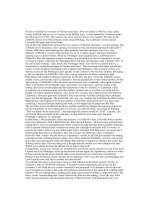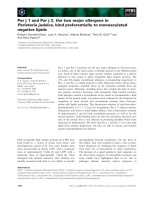Vision and Mission The Two Key Anchors That Add Passion and Purpose to Your Story
Bạn đang xem bản rút gọn của tài liệu. Xem và tải ngay bản đầy đủ của tài liệu tại đây (287.85 KB, 28 trang )
Vision and Mission: The Two
Key Anchors That Add Passion
and Purpose to Your Story
T
his chapter defines the heart of your story. To build an effective
plan you begin by putting two stakes in the ground. The first of
these is the vision statement and the second one is the mission
statement (see Figure 4-1). This chapter deals in detail with both
elements. Here I tackle controversial issues such as top-down versus
bottom-up visioning. Because they are often confused and consid-
ered the same thing, I clearly separate the definitions and purposes
of vision and mission by describing the roles and functions that
85
CHAPTER
4
each has in developing your plan. I go further by explaining how to
look at your mission in a new light. This new concept is called mis-
sion analysis and gives you a detailed review of what is required by
the mission statement.
Seven Steps to a Successful Business Plan
86
Figure 4-1. The mission and vision serve as the two end points for the
path of your plan.
Putting stakes in the ground gives you anchor points for your
plan and creates stability by defining start points and end points of
your planning. One stake defines where you are now and the other
defines where you want to be in the future. Neither can be absent
from your story since they are the originators of your plan’s purpose
and passion. By knowing the two end points of your plan, you can
add pieces and parts of the planning process. From these anchor
points you build an integrated model of many critical items, which
combine to form your story.
T
HE
T
WO
C
RUCIAL
P
ARTS OF THE
V
ISIONING
P
ROCESS
Let’s put the first stake in place. The vision stake contains two parts
(see Figure 4-2):
1. The vision itself
2. The vision statement
These two parts are different but so closely integrated and
interdependent that they cannot be separated. Both must be pres-
ent in your thinking and should be developed at one time in the
process.
Vision and Mission
87
Figure 4-2. The vision and the vision statement together provide the
direction of the plan.
One part, the vision statement, is short and to the point,
whereas the vision itself can be lengthy and somewhat vague. As
you build your plan, these two parts must be discussed. The vision
statement becomes part of your written documentation in the
business plan itself. The longer vision may be captured in narrative
as part of the company’s recorded history.
T
ECHNIQUES
T
HAT
C
AN
H
ELP
Y
OU
C
REATE A
P
OWERFUL
C
OMPANY
V
ISION
The vision is the guiding focus of the company’s direction. Without
a direction the company is lost, wandering around the landscape of
the business environment. Employees are disillusioned with the sit-
uation because they cannot see an end game. I believe that people
come to work each day expecting to move toward some goal. That
means they need direction to their existence. Companies without
this fundamental element are doomed to exist from day to day, act
only in a reactive mode, and be forever chained to the present.
Scenario Writing: Where Are You Heading?
Direction provided by the vision can be written many ways. A use-
ful tool for developing the vision is called scenario writing. You
may choose to describe multiple versions of your vision. Two exam-
ples or versions will give you different perceptions of how you want
to proceed. One version may be an extension of the present situa-
tion but improved over time. This means you are satisfied with your
present business but would like it to grow or be more profitable.
Visualize making your existing business much bigger. A second
vision scenario may ask you to change your current business into
something different but better. This could mean growing from your
present product or service line into something quite different. For
example, you may be presently in the insurance business. Looking
into the future you expect a certain part of your business to grow to
the point where it becomes the dominant income producer. Your
Seven Steps to a Successful Business Plan
88
main income might then be from brokering stocks and bonds. Ten
years down the road your company name may still be the same but
your products may be completely different as you slowly gain more
definition and clarity of what your vision really meant.
Keep Your Focus Future-Oriented
Other factors distinguish the vision as a concept that is different
from the mission or other parts of your story. The vision must obvi-
ously be future-oriented. This means you must think outside the
box of today and describe the world of the future. Since the vision
can be anything you want it to be, it may be recorded as fragments
or it may be a complete document. The vision can include a num-
ber of diverse points or it can be very focused. Because the vision is
a description, it should be stimulating in phrases and wording. The
vision must paint a picture that attracts employees through the use
of visual imagery. This is what hooks people into passionate buy-in,
subsequent followership, and cheerful implementation of the plan.
The idea that a vision has to be a completely thought-out,
stand-alone piece of work is not necessarily true. Often just the
concept of where you want to go as a leader can fire the imagina-
tion of the company. Consider Steven Jobs’s idea that every person
should have access to a computer. Consider what kind of story was
built around that simple but elegant vision. Maybe entrepreneurs
cannot fully explain their vision on the first pass, but they can
anchor the idea. That is often enough to build successful compa-
nies. In the movie
Field of Dreams, Kevin Costner was visited by a
voice that told him, “Build it and they will come.” His character
then began a quest to find out what that voice meant. In the begin-
ning he had no clue, just a belief that the message was important.
During the journey he found another believer and then a third,
who reinforced his vision. Later Costner’s character “bet the farm,”
putting his entire future at stake to fulfill the dream and make it a
reality.
Vision and Mission
89
Add Keywords to Fire the Imagination of Your
Employees
The stimulating factor of a vision cannot be underestimated. By
using keywords in telling a story the leader stirs the imagination,
bonds employees with common purpose, and creates hope for the
future. Howard Gardner’s simple but elegant description seems to
fit: “And still others have investigated the primary purpose of
stories—binding together of a community, the tackling of basic
philosophical or spiritual questions, the conferral of meaning on an
otherwise chaotic existence.” In his book Leading Minds, he builds
example after example of the power of stories and linking people
through a common imagery.
1
The vision must include concepts that capture people’s atten-
tion and create the passion necessary for successful planning.
Inherent to the visioning process are words that convey the follow-
ing information:
■ Size. What size company could you become in ten years?
Just how big do you want to grow the company? How
hard are you willing to work?
■ Geography. Where do you want to be located in ten years?
Are you willing to do what is necessary to expand, often
into other countries with different rules, regulations, and
business climates?
■ Markets. Are you willing to shift markets from your exist-
ing one to an emerging market, one that could be risky?
■ Products, Goods, and Services. Are you willing to give up
old-line products and sacred cows for new ventures that
may be different from your company’s history? How dif-
ferent would it be to move from a producer of goods to a
deliverer of services in ten years?
These are just examples of items you must consider when
developing your overall vision. Combine these key concepts when
painting the picture of the future. Substitute the words
planner or
Seven Steps to a Successful Business Plan
90
president in Gardner’s quote and you build a case for using imagi-
nation in the planning process.
There is one more idea I’d like to introduce. I find it cold and
distracting when writers downplay the power of emotion in an
organization’s plan or story. The component of emotion is critical
in developing the psychological tie-in of employees to the business
plan. But don’t confuse the value of employees’ emotional connec-
tion with the concrete aspect of the vision. Too often the analytical
writers try to equate vision and the visioning process as some blind-
ing flash of the future without substance. They are simply mixing
the strategic goals of a business plan with definition of the vision.
This shows a lack of understanding of planning as an integrated
model. Of course you must convert your vision into measurable,
doable actions. To believe the vision carries itself on its own
strength is fantasy. (Further explanation of the conversion of the
vision into strategic goals is offered in Chapter 5.)
T
HE
V
ISION
S
TATEMENT
: H
OW TO
D
ESCRIBE
Y
OUR
C
OMPANY OF THE
F
UTURE
The second part of the visioning process is the vision statement.
This is a statement that captures the essence or spirit of how you
describe the organization of the future. Here are some guidelines for
getting started:
■ Make your description short and to the point. Sometimes the
description is vague to the outside reader. That’s not bad.
Because the complete vision is a long paragraph or numer-
ous pages, the shorter vision statement is ideal for inclu-
sion in the business plan.
■ Don’t be concerned with the vagueness or brevity of the vision
statement.
Vagueness in sentence structure gives you an
opportunity to have a quality communications event with
employees. In fact, you want them to ask about the defi-
nition of the vision statement because it gives you a
Vision and Mission
91
chance to explain details of your thinking. This was not
meant to be a license to create a deliberately vague vision
statement. There will be enough of those.
■ Don’t try to write a vision statement that is so clear it will be
understood by 100 percent of your employees on the first pass.
That is just not realistic. If you want clarity in your vision
statement, ask yourself this: Can you fully explain it to
anyone who asks?
Here are several examples of vision statements taken from busi-
ness plans of assorted organizations. While they differ in length, all
are short, powerful, and achieve positive responses from employees:
Examples of Vision Statements
■ To be the respected leader and credible information source
for all issues related to the forestry community.
■ The people of HRD Canada, New Brunswick Region, make
a difference in the lives of New Brunswickers and
Canadians. By contributing to the improvement of social
and economic conditions in our province, we are working
toward the achievement of people’s full potential and the
elimination of poverty in our communities.
■ Our vision is to dominate the world market with our
products.
■ Beat big blue!
■ To build the smallest, most user-friendly computer in the
world.
■ The Creative Kitchen Company will become well known
for solving complex kitchen renovation problems.
■ The company customers will turn to for help in resolving
their difficult business situations.
■ To be rated among the top 100 companies to work for in
North America.
Seven Steps to a Successful Business Plan
92
■ To build houses, each leaving only a wheelbarrow full of
scrap.
■ To set new standards of on-time delivery and accuracy at
the international level.
■ Our products will achieve public recognition for quality,
durability, and safety.
■ To touch every household in North America with at least
one of our product lines.
■ Our bed and breakfast chain will become the symbol for
your “home away from home.”
■ To become the most highly sought-after tree service in the
state of Virginia.
■ To make our seafood line the most recognized within
North America.
■ To provide our customers with exotic flowers from around
the world today.
■ To have my gowns featured in Vogue magazine.
Martin Luther King Jr. touched spirits and enflamed souls with
his famous “I have a dream” speech. If you don’t believe in “this
vision thing,” consider how that one speech changed a nation and
forever shaped history. Consider how a new president at Savage Arms
saved the company when he appealed to the employees with words
to this effect: “This company is a piece of American history. We are
too valuable to let it die. We are going to salvage this company.”
Getting a vision down to a single phrase or sentence is not an
easy task. The best way to extract the vision statement from the dis-
cussion or scenario-writing exercise during a planning session is to
let it evolve. Capturing a powerful vision statement is not some-
thing that can be done on cue or at a scheduled time in the plan-
ning process. You often find a team discussing the vision at length
and not being able to immediately define the vision statement.
That’s okay. Don’t force the issue. Sooner or later the team will cir-
Vision and Mission
93
cle back around to the issue of vision statement and write an
acceptable version.
A critical by-product of the vision statement is the creation of
passion, which is the outward expression of emotion. The dynam-
ic of passion surrounding the vision and the vision statement cre-
ates an energy field or field of vision. Admittedly, this is an intan-
gible but nonetheless real organizational dynamic. When visiting
an organization that has a well-communicated vision, an energy
field is very much in evidence. It manifests itself in the way people
carry out their duties, the way they deal with customers, and the
way they approach one another. A company with a field of vision
is an exciting place to work. People know their work is important,
is meaningful, and has purpose. This energy is translated into high-
er motivation levels and better performance.
A significantly higher level of performance can be found in
organizations with a vision than those without a vision. Often you
find good people, people who want to perform but have no emo-
tional outlet. There is no vision to create passion for their work. I
am saddened to find good companies with good people and good
products managed by presidents with no vision. While there are
many leaders with outstanding operational skills, these same indi-
viduals often have little or no visionary skills. Because visioning is
a core competency of a leader it goes without saying the leader is
responsible for setting the vision and facilitating the executive team
in developing the vision statement—and ultimately, for being the
cheerleader for the field of vision. The president of the company is
the number-one advocate of the vision. Without a public display of
emotion of the vision, the business plan will have a stillbirth.
The president or leader of the business unit creates the initial
vision. This is done in draft and communicated to the executive
team in the first planning activity. It is one of the first pieces of
information discussed in the preplanning meeting.
The suggestion of the president being responsible for the vision
is very different from the current popular trend of bottom-up
visioning. In my consulting experience I have never found a single
Seven Steps to a Successful Business Plan
94
instance where the bottom-up approach to building a company
vision has been successful. Occasionally management teams try to
claim this distinction, but on close examination their claims are
easily refuted.
Now let’s tackle the controversy of a leader’s single vision ver-
sus that of the masses. A single leader vision pushed down stands a
high chance of failure. A leader can have a compelling vision but
not get it institutionalized. That can happen when the manage-
ment team doesn’t buy the vision or they don’t communicate it
downward with the same degree of passion.
D
ON
’
T
C
ONFUSE THE
M
ESSAGE
W
ITH THE
M
ESSENGER
The question of who writes the vision gets further muddled when
we examine the center or core of the message. Is it something the
leader wants to do, or is it a summation of unspoken needs by a
multitude of people? Let’s not confuse the message with the mes-
senger in this case. Often the president is simply someone who cen-
ters the vision for the company by putting it into words or symbolic
meaning. This means he or she simply articulates what is felt con-
sciously or unconsciously in the hearts and minds of the employ-
ees. The vision, therefore, is not one person’s dream. It is the expres-
sion of many dreams, hopes, and desires. But someone must take
the lead to articulate, champion, and energize those dreams
2
Someone must create a rally point in time of uncertainty or chaos.
That someone is not a committee, a group, or a mass of employees.
It is the ethical responsibility of the top management team to
assume the mantle of leadership and have the courage to put the
stake in the ground.
3
Vision and Mission
95









